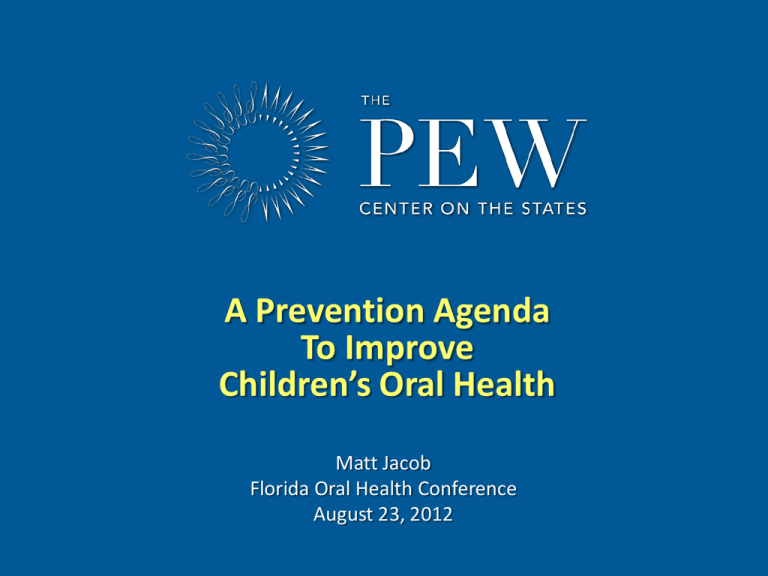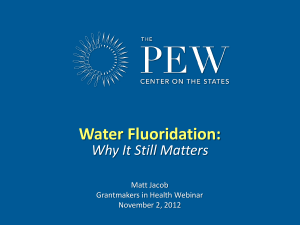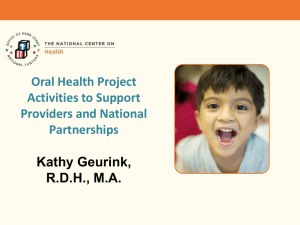
A Prevention Agenda
To Improve
Children’s Oral Health
Matt Jacob
Florida Oral Health Conference
August 23, 2012
www.pewcenteronthestates.com
The impact of unmet dental needs
• Preventable dental conditions were
the primary diagnosis in 830,000+
visits to hospital ERs nationwide in
2009 — a 16% increase from 2006.
• Children accounted for nearly 50,000
of these ER visits.
• Many ER visits are made by Medicaid
enrollees and the uninsured, meaning
these visits impose a cost on
taxpayers and consumers.
Florida: The number of Medicaid enrollees seeking ER care
for dental problems jumped 40% over a two-year period.
www.pewcenteronthestates.com
2
The driving factors
• More than 100 million Americans
lack dental insurance.
• States are not investing enough in
proven forms of prevention.
• Inadequate Medicaid funding leaves
big gaps in coverage.
• The dental workforce lacks the
capacity to address all of the unmet
need.
www.pewcenteronthestates.com
Better Use of
Prevention:
– Fluoridation
– Dental Sealants
www.pewcenteronthestates.com
Community water fluoridation
Community water
fluoridation is endorsed by
the American Academy of
Pediatrics, the American
Dental Association and other
leading health authorities.
Fluoridated water reduces
tooth decay by 25%.
It’s the most cost-effective
oral health intervention.
Every $1 invested in water
fluoridation saves $38.
Source: Centers for Disease Control and Prevention, www.cdc.gov/fluoridation
www.pewcenteronthestates.com
Slow, steady growth for fluoridation
Millions of Americans on Public Water Systems
Who Receive Optimally Fluoridated Water
210
200
190
180
170
160
150
140
130
120
1988
1992
2000 2002
2004
2006
2008 2010
Year of Fluoridation Data
CDC named community water fluoridation one
of “10 great public health achievements of the
20th century.”
www.pewcenteronthestates.com
But this is no time to celebrate
• 72 million Americans do not receive community water fluoridation (CWF).
In many states, anti-fluoride activists are trying to stop CWF, ending a
proven strategy to prevent tooth decay.
l
Tennessee’s Speaker of the
House publicly urged state
officials to stop promoting
CWF.
l
In Nebraska, 80% of the
towns voting chose to opt
out of a fluoridation law
(2008-2010).
l
One of Florida’s largest
counties voted in 2011 to
discontinue CWF.
www.pewcenteronthestates.com
How does Florida measure up?
l
Florida ranks 25th out of the 50 states in
the percentage of residents receiving
optimally fluoridated water.
l
More than 3.7 million Floridians live in
homes with no access to CWF.
l
Fluoridation debate has been very intense
in Florida over the past 12 months
www.pewcenteronthestates.com
8
Pew’s research on fluoridation
• Media analysis of newspapers, social media and search-engine results
• Research of opposition messages used online and in social media
• Focus groups and interviews with stakeholders in communities where
fluoridation has been hotly debated in recent years
– Palm Beach, FL; Wichita, KS; York, PA; and San Diego, CA
• National survey of the public
• Message testing of pro- and anti-fluoridation leaflets with groups of
“active citizens”
• Focus groups of water operators in Mississippi
www.pewcenteronthestates.com
Fluoridation:
Lessons Learned
www.pewcenteronthestates.com
Public awareness is low
How Informed Are You
About Fluoridation?
Survey of 1,503 adults (2010)
Very
Informed
20%
Somewhat
Informed
54%
Not at All
Informed
26%
• Maryland survey: 58% of
residents could not identify
the purpose for adjusting
the fluoride in public
drinking water.
• 80% of Americans admit
they have a low level of
knowledge about
fluoridation.
www.pewcenteronthestates.com
Public awareness is low
How Informed Are You
About Fluoridation?
Survey of 1,503 adults (2010)
Very
Informed
20%
Somewhat
Informed
54%
Not at All
Informed
26%
• Maryland survey: 58% of
residents could not identify
the purpose for adjusting
the fluoride in public
drinking water.
• 80% of Americans admit
they have a low level of
knowledge about
fluoridation.
www.pewcenteronthestates.com
Opponents: Persistent and web-savvy
Opponents
are aggressively
posting web
content, courting
media coverage
and circulating
anti-fluoride
videos.
www.pewcenteronthestates.com
Comparing each side’s tactics
• They are speaking to the public and
successfully targeting key audiences.
• They use ordinary language to
spread fear and doubt.
• They have a strong presence online
and in social media.
Water Fluoridation:
A Corporate-Inspired Scam
• We are more likely to communicate
through conferences and list-servs.
• We often use clinical language and
don’t do much to correct distortions.
• We have a relatively low profile on
the web and in social media.
www.pewcenteronthestates.com
A perfect storm
• The vacuum of public
knowledge gets filled by
the misinformation online
• The growing distrust of
government’s role in
health or other issues
• The public health
community is complacent
• Opponents have learned
to package their
arguments as science
www.pewcenteronthestates.com
Takeaway: Avoid clinical language
Dental Health and Fluoride Treatment
Debate Continues
Over Fluoridation
Using the word “chemical” plays
into the fear-based message of
anti-fluoride activists
Wichita’s water supply has sparked
a debate for decades that has pitted
health professionals against everyday Kansans as to whether to flouridate it or not. “It's one
of the most highly studied chemicals we've ever had,"
said Wichita dentist Dr. Brick Scheer.
www.pewcenteronthestates.com
Takeaway: Frame the issue correctly
This is a winning
Preventing
message wheel
Decay
for oral health Kids and
advocates
Adults
Avoid Pain
Reduce
Health
Care Costs
Better
Overall
Health
Healthy
Teeth
Kids Miss
Fewer
School Days
Better
Job
Prospects
Eat and
Smile with
Dignity
Seniors
Keep Their
Teeth
www.pewcenteronthestates.com
Takeaway: Frame the issue correctly
Opponents
Fluorosis
are likely to
Lower
Cancer
win if the
IQs
Bone
dialogue is
Fractures
trapped
Arthritis
inside this
Hypomessage
Kidney
thyroidism
&
wheel
Problems
Alzheimer’s
Harms
Risks
Migraines
Nervous
Violent
System
Crime
Problems Autism
www.pewcenteronthestates.com
Takeaway: Lead with the need
How messages affect existing support:
More than 35% of children in Oregon have
untreated dental disease.
Much
More
Somewhat No
More
Effect
60%
26%
12%
39%
36%
21%
Studies prove that fluoride prevents and can
even reverse the process of tooth decay.
47%
35%
13%
Communities have a moral obligation to ensure
that all residents benefit from fluoride —
something that is proven to improve oral health.
31%
36%
20%
The typical city saves $38 for every $1 invested
in water fluoridation.
47%
38%
11%
The CDC has called fluoridation one of the
“ten great public health achievements of the
20th century.”
www.pewcenteronthestates.com
Takeaway: Lead with the need
How messages affect existing support:
More than 35% of children in Oregon have
untreated dental disease.
Much
More
Somewhat No
More
Effect
60%
26%
12%
39%
36%
21%
Studies prove that fluoride prevents and can
even reverse the process of tooth decay.
47%
35%
13%
Communities have a moral obligation to ensure
that all residents benefit from fluoride —
something that is proven to improve oral health.
31%
36%
20%
The typical city saves $38 for every $1 invested
in water fluoridation.
47%
38%
11%
The CDC has called fluoridation one of the
“ten great public health achievements of the
20th century.”
www.pewcenteronthestates.com
Takeaway: Lead with the need
Airing a TV ad in Portland that
emphasizes the oral health problems
www.pewcenteronthestates.com
Takeaway: Start reclaiming the web
www.pewcenteronthestates.com
Takeaway: Start reclaiming the web
iLikeMyTeeth.org
frames CWF in the
broader context of oral
health (protecting teeth)
www.pewcenteronthestates.com
The Campaign for
Dental Health
(iLikeMyTeeth.org)
www.pewcenteronthestates.com
The Campaign for Dental Health
Objectives:
Create a national network of
CWF advocates who can share
ideas, offer insights, and
support one another
Improve the quality and
accuracy of web content about
oral health and CWF
Provide state and local
advocates with fact sheets,
PowerPoint slides and other
helpful resources to support
their work
www.pewcenteronthestates.com
Sample of campaign partners
A campaign with diverse partners:
www.pewcenteronthestates.com
The web presence
Allowing advocates to create a locally customized
web presence for their CWF campaign
www.pewcenteronthestates.com
PowerPoint slides for advocates
www.pewcenteronthestates.com
Building awareness of the campaign
Insert Photo of
Florida Dental Van
www.pewcenteronthestates.com
Launching a rapid-response team
Providing balance
to the anti-fluoride
opinions that used
to dominant online
discussions
www.pewcenteronthestates.com
Helping the media frame the issue
Reverse the decay
of common sense
This is a defining moment for Pinellas
County, where Midwestern sensibilities run
deep and extremism usually fails. It's been
nearly three months since the county
stopped putting fluoride in its drinking
water
The reason: Four county commissioners
sided with a handful of tea party followers,
conspiracy theorists and a tiny anti-fluoride
group misnamed Citizens for Safe Water.
Nancy Bostock, Neil Brickfield, John
Morroni and Norm Roche turned their
backs on established science and public
health.The evidence that fluoridating drink-
-ing water is safe and prevents tooth
decay is strong and is widely embraced
too. The Centers for Disease Control and
Prevention, the U.S. Environmental
Protection Agency, the American Dental
Association, the Florida Department of
Health and the Pinellas County Dental
Association stand behind it.
Yet these four county commissioners
voted last fall to stop spending $205,000
on fluoridating water to improve the
dental health of 700,000 residents. The
annual savings per resident works out to
29 cents.
The first U.S. cities began adding
fluoride to their water supplies in the
1940s. Now, 196 million Americans are
drinking fluoridated water, including more
than 13 million Floridians. St. Petersburg,
Dunedin, Gulfport and Belleair are on
separate systems and continue to
fluoridate their drinking water. And so do
Sharing info
with editors
and reporters,
fact-checking
stories and
encouraging
pro-fluoride
editorials
www.pewcenteronthestates.com
The campaign’s progress
More than 350 users are registered to
access advocates-only materials through
iLikeMyTeeth.org — a 43% jump since
March.
Local websites have been created by
advocates in 7 states.
The Campaign provided talking points
and other assistance to local advocates in
Montana, Florida and Oregon who
successfully won local fluoridation votes.
More than 540 Tweets have been sent
since our Twitter account was launched
in January.
The Campaign has more than 30 local,
state and national partners.
www.pewcenteronthestates.com
Pew’s outreach to states
OR: Offering
funds and
research for
a campaign
in Portland.
MT: Assisted successful
effort to preserve CWF
in the city of Bozeman.
WI: Provided research and
technical assistance to
preserve CWF in Milwaukee.
NH: Helped
defeat a
statewide
ban on CWF.
CA: Provided
assistance to
a successful
campaign to
secure CWF
in San Jose.
KS: Assist oral
health advocates in
Wichita pass a
fluoridation policy.
AR: Funded a poll and offered
other assistance to pass a
state mandate in 2011.
MS: Provided
message
training for
oral health
field staff.
www.pewcenteronthestates.com
33
Dental Sealants
www.pewcenteronthestates.com
Dental sealants
Dental sealants are clear,
plastic coatings that are
painted onto children’s
molars, which are the most
cavity-prone teeth.
Sealants are usually applied
when molars first appear in
the mouth — at age 6-7 and
also at age 12-13.
Sealants prevent 60% of
decay at one-third the cost
of a filling.
Source: Centers for Disease Control and Prevention,
http://www.cdc.gov/oralhealth/publications/factsheets/sealants_faq.htm
www.pewcenteronthestates.com
An under-utilized strategy
Despite the proven benefits of sealants
for high-risk children:
l
l
Only one out of five teenagers aged
13-15 received sealants on at least
one of their first set of molars and at
least one of their second set of
molars.
Between 2005 and 2008, only about
20% of low-income children received
sealants, compared with 32% of kids
from families at higher income levels.
www.pewcenteronthestates.com
An under-utilized strategy
A sealant gap also exists
by race and ethnicity
Percentage of children
receiving sealants
(2005 -2008)
30%
22%
17%
AfricanAmerican
MexicanAmerican
White
www.pewcenteronthestates.com
What’s standing in the way of progress?
Prior Exam Rules Create Unnecessary
Barriers in Many States
Dentist’s exam and
direct or indirect
supervision
required (10)
WA
Dentist’s exam
always required
(10)
Dentist’s exam
sometimes
required (16)
ME
ND
MT
OR
VT
MN
ID
SD
WY
RI
PA
IA
UT
IL
OH
IN
WV
CO
CA
KS
MA
NY
MI
NE
NV
NH
WI
MO
VA
KY
CT
NJ
DE
MD
DC
NC
Dentist’s exam
never required (15)
AZ
OK
NM
TN
SC
AR
MS
TX
AL
GA
LA
FL
AK
HI
Source: Pew Center on the States data from survey of state oral health programs and state boards of dentistry,
2011-12.
www.pewcenteronthestates.com
38
The prior exam rule
• It isn’t supported by science.
– A CDC panel of experts concluded that a
comprehensive dental exam is not
required to determine if a tooth should
be sealed.
– A visual assessment by a hygienist is
sufficient before sealants are placed.
• It raises the cost of sealant programs.
– When Virginia launched a pilot program
that lacked a prior exam rule, state
officials found that the average per-child
cost of this program was 20% lower than
applying sealants with a prior exam.
www.pewcenteronthestates.com
The prior exam rule
• It isn’t supported by science.
– A CDC panel of experts concluded that a
comprehensive dental exam is not
required to determine if a tooth should
be sealed. A visual assessment by a
hygienist is sufficient.
• It raises the cost of sealant programs.
– When Virginia launched a pilot program
that lacked a prior exam rule, state
officials found that the average per-child
cost of this program was 20% lower than
applying sealants with a prior exam.
Pew survey: Reducing restrictions on hygienists was “the most frequently
noted policy” that would help to expand school sealant programs.
www.pewcenteronthestates.com
Billing issues can pose obstacles
Only 15 states allow hygienists to bill Medicaid
directly for dental services they provide
• Arizona
• Montana
• California
• Nebraska
• Colorado
• New Mexico
• Connecticut
• Nevada
• Maine
• Oregon
• Massachusetts
• Washington
• Minnesota
• Wisconsin
• Missouri
Source: The American Dental Hygienist’s Association
www.pewcenteronthestates.com
How Pew is helping states
This year, Pew has provided
research and technical support to
advocates in several states who
have worked successfully to change
restrictive sealant laws or rules.
www.pewcenteronthestates.com
Pew’s upcoming 50-state report
• It will grade every state on
4 benchmarks that are
related to dental sealants
• It will explore whether
states are allowing
unnecessary rules to
obstruct their ability to
provide more kids with
sealants
• It will be released this fall
www.pewcenteronthestates.com
Keep informed . . .
of these and other oral health issues by
receiving Pew's monthly e-newsletter –
Dental News & Views.
Send an email to mjacob@pewtrusts.org
with the words “Subscribe“
in the subject line.
www.pewcenteronthestates.com








